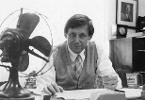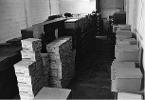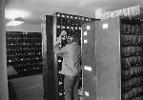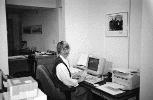History of The McCall Library

Plan of Mobile and of Fort Conde. Map drawn by Devin, 1734. Archives Nationales, Paris
Dr. Michael Thomason (photo below), a University of South Alabama history professor, founded the University of South Alabama Photographic Archives on May 31, 1978. Since 1975, Thomason had been working with a colleague, Dr. Melton McLaurin, on a history of Mobile (and later a history of Alabama) that needed historical images. The two found a large collection (circa 100,000) of historic negatives in the basement of the Mobile Public Library. The images had been taken by commercial photographers Erik Overbey and William Reed between about 1880 and 1963. Because the public library did not have the staff or the resources to make reproductions from the negatives, it allowed patrons to check them out for duplication off-site by others. Naturally, negatives were at times returned damaged, broken, or not at all. With the assistance and support of Dr. Dave Horton, then the university's vice-president for academic affairs, after lengthy negotiations with the library, it agreed to transfer its collection to the university with the stipulation that the university improve the collection's housing and care. The Overbey and Reed collections were transferred from the library to a building located at Brookley Field, then a satellite campus of the university situated on Mobile Bay. The archives opened in October of 1978 with Michael Thomason as its director, a position he held until his retirement from the university in 2006. The conditions asked for by the public library were met and after a decade the collection became the property of the university.
The photographic archive soon came to hold more than negatives, slides, and prints, however, and the name was changed to the University Archives. Unfortunately, Brookley was not the best location for an archives but it was all that was available in May 1978. The building in which it was located was hard to cool and threatened continually by storms. It survived Hurricane Frederic in 1979 without damage but disaster finally struck in May 1989 when a waterspout hit the Brookley campus. The storm ripped the roof off the archives' building, putting the collections in danger. Thomason, with the help of many volunteers and friends, quickly moved the archives to a new location at the university's Springhill Avenue annex. The feat was accomplished in less than seventy-two hours!
The archives re-opened on June 7, 1989. The complex logistics of that move were coordinated by Elisa Baldwin (seen below) who began her career at the archives shortly after it was established. In the early years Baldwin's modest pay came from grants and the profits from the sale of prints from the Overbey and Reed negatives, many of which she personally made in the darkroom that Thomason had set up for that purpose. Eventually she became a tenured member of the university library faculty (the archives had been made a division of the library shortly after it was founded). Baldwin served the archives faithfully until she retired at the end of August 2005. Her role in the development of the archives was crucial.
Since its move to Springhill Avenue, the number of collections held by the archives has increased dramatically. The McCall Library, with over 4.2 million negatives, prints, and slides, now holds the largest photograph collection in the region. In 2007, more than fifty of our images were featured in the Ken Burns documentary The War. Our rich photographic history of the city – a place that was greatly affected by World War II – was one reason the award-winning filmmaker gave for including Mobile as one of the four cities that were the subject of his documentary. In the years prior to and after The War the material held by The Library has been used to illustrate or write numerous books, articles, theses, and dissertations, and our photographs have been used for everything from decorating office space and advertising clothing to gracing pavilions in Hong Kong and as placemats for wedding receptions.
Carol Ellis replaced Elisa Baldwin as archivist on September 1, 2005. She was named director in 2010. On May 6, 2011, the archives’ name officially changed to The Doy Leale McCall Rare Book and Manuscript Library after Doy Leale McCall Sr.'s grandchildren donated a valuable and historically significant collection of eighteenth, nineteenth, and twentieth century documents amassed by McCall and valued at $3.1 million. You can read more about that collection here. The Library has provided numerous university history grad students with practical work experience. On May 31, 2013, The Library celebrated its thirty-fifth year.
In 2016 the McCall Library completed its relocation to campus taking over space on the third floor. With a custom built mahogany-trimmed reading room and secure closed stacks, the McCall library now serves the campus and community with access to its growing photograph and manuscript collections.
In 2017, the McCall library hired a new librarian, Deborah Gurt, as Processing and Digital Archivist and in 2018, celebrated its 40th anniversary with a special visit from photographic historian Fances Robb. In 2019 Gurt was named Interim Director after the retirement of Carol Ellis.
In 2021 a large donation from Thigpen Photography Studio doubled the size of the McCall
Library image collection to its current 4.2 million images. This collection features
everything from black-and-white history to colorful Mardi Gras scenes, along with
numerous aerial images from Mobile Bay and the Gulf Coast.
A 2021 National Endowment for the Humanities grant allowed the McCall Library to expand
and formalize its oral history program which aims to fill in gaps in documentation
of Mobile's history. These growing community oral history collections include the
Jewish Mobile Oral History Project, the Down the Bay oral history project, and the
Excelsior Band collection, among others.
In September 2024, Gurt was named Director of the McCall Library. The McCall Library continues to expand its collections and share them with ever-wider audiences.








